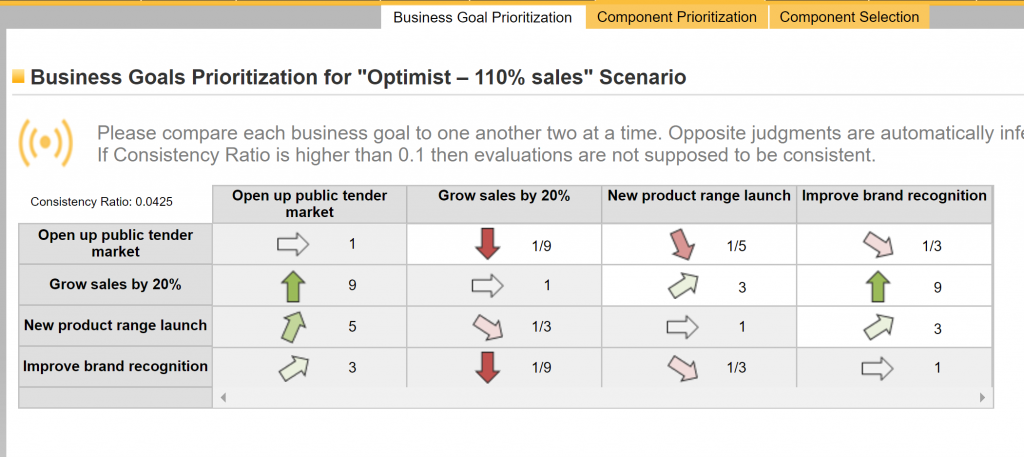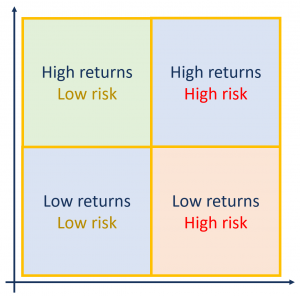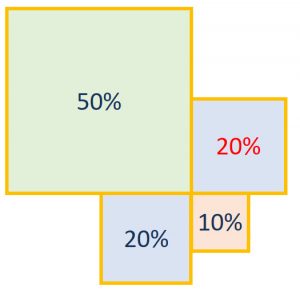 Managing a portfolio of innovative projects incurs many difficulties, such as the establishment of a culture of continuous evaluation in order to validate the hypothesis, or the difficult collaboration of multidisciplinary teams with no prior experience to rely on. For those who lead the innovation strategy, the biggest challenge is to have a tool that allows distinguishing the relative importance of each project in order to prioritize its implementation.
Managing a portfolio of innovative projects incurs many difficulties, such as the establishment of a culture of continuous evaluation in order to validate the hypothesis, or the difficult collaboration of multidisciplinary teams with no prior experience to rely on. For those who lead the innovation strategy, the biggest challenge is to have a tool that allows distinguishing the relative importance of each project in order to prioritize its implementation.
As the ratio between innovative ideas and projects reaching the final stage is very low, it is especially important to ensure that the highest value projects are approved. It is worth noting: innovation projects are very inefficient. It is necessary to spend time and money on research until you get an idea that is really worth pursuing. But that does not mean that you do not have to control how much time and money you spend, or what activities.
That is why this type of portfolio usually follows a lean philosophy: it starts from a hypothesis or idea that must pass through successive phases of refinement and validation.
Thus, before the existence of a project in the execution phase, there is the proto-project: first the idea or hypothesis, then the MVP, which requires pivot points. When the starting hypothesis is not endorsed by actual experience, or only partially, the proto-project can be reoriented in the light of what has been learned.
As pivoting generates additional costs in the search for commercial and technical viability, innovative proposals must be constantly evaluated to consider which ones should have room to generate inefficiencies and additional costs until a sound foundation is found - and which are discarded so that the investment is sustainable.
Innovation and corporate values
Innovation projects in large corporations are usually characterized by responding to a vision that goes beyond the business, also pointing to values such as Corporate Social Responsibility, environmental sustainability or the consolidation of one's own innovative culture.
For example, BBVA has an ambitious innovation strategy centered on Big Data. As the ultimate goal is to better understand the behavior of customers to provide better services, efforts are directed towards knowledge creation. With important ramifications: the key professional is no longer the traditional financier, but the data scientist, who "dominates statistics, knows how to program and also understands the business". The various initiatives that emerge from BBVA's Big Data strategy struggle for finite (though abundant) resources, which is why Marco Bressan has decided to concentrate on the centralization of information to begin with.
Start prioritizing your portfolio of innovative projects with ITM Platform
On the other hand, the means that any corporation has to materialize an innovation strategy is its portfolio of projects. In order for the portfolio of projects to have sufficient bearing, portfolio management must be the explicit responsibility of a corporate unit, often the management committee itself.
In the case of General Electric (GE), verticals include aviation and transportation, but they extend to materials as diverse as software, health services and water.

A sample of the diversity in GE's innovative portfolio
Unfortunately, as innovative projects are often completely unpublished and very different from each other, it is often difficult to know which projects are to be given preferential treatment. Is it more important that the project produces a social return or contributes to the modernization of the technological infrastructure?
Given the difficulty of comparing two innovative projects and knowing which will bring greater value to the company, it is crucial to have a criteria for making complex choices objectively.
Complex decisions are often subjective
A complex choice is one in which the alternatives are weighted based on more than one quality, so that there is no optimal alternative that surpasses the rest.
For example, several factors are taken into account when choosing an internet service provider: price, quality of customer service, the speed of the line and the reputation of the company. Usually the more economical services offer lower speeds, while more established brands often offer improved after-sales services. The decision is never obvious.
Complex choices are made daily. Often, as is the case with internet providers, the final decision is usually subjective, because whoever decides does not have the necessary time or tools to decide which option gives the maximum value. This hasty dimension of the decision allows competitors to appeal to the consumers' emotions and win with arguments less related to the service itself.
However, it is obvious that whoever leads the innovation program of a corporation can not be carried away with emotion. You will have to give reasons for your decisions, rely on data and get the push and commitment of many teams, who often work in remote locations.
Complex corporate decisions:
Portfolio prioritization with AHP
Without a technique or method to compare between the different value criteria, each choice between projects is difficult, equivalent to the choice between ethical values, such as freedom and equality.
Although there are dozens of prioritization methodologies for product requirements, there are not many alternatives in the world of project management.
The most convenient method for responding to complex choices representing the alternatives between innovative projects is AHP, an acronym for Analytical Hierarchy Process.
In short, AHP is advisable because:
- It helps build consensus around how to implement the innovative portfolio strategy
- It is linked by definition to the criteria, values and business objectives
- Shorten the political discussions
- Increase the commitment with the decisions taken, since all the criteria of the corporation are represented in the right measure.
This technique allows for comparing, in a table format, the relative importance of each criterion or objective.

The resulting table does not hierarchize in absolute terms. That is to say: it does not classify the objectives from more to less important, since that is an oversimplification. On the contrary, it allows us to attend to fundamental nuances when it comes to assessing the diversity of value propositions delivered by innovative projects.
For example, in the case of an innovative portfolio one could compare the importance of the following objectives:
- Improving innovative culture
- Increase market share in digital services
- Modernize the technological infrastructure
Let us now imagine that the management committee of a corporation devotes a meeting to compare these objectives and discuss which is more important for the strategy comparing them in pairs. The conclusion would be something like the following table:

Although matrices can be done by hand or in Excel, it is convenient to have software that allows calculation and is integrated with the project management itself, such as ITM Platform.
Thus, not only is there a system that helps to perform the analysis, but its results are registered and connected with the evaluation of the projects themselves.
By linking each project to the objectives and criteria it supports, ITM Platform indicates which projects contribute the most value and should start sooner.
Of course, the work of evaluating the proposals will remain a difficult art, as well as the elaboration of innovative proposals, with all the market prospecting exercises, identification of tendencies and uncertainty for the future.
But there is a basis in the management of the information that must be demandable. The facilitated prioritization that we have explained in this article has the great advantage of generating consensus and supporting informed, renegotiable and easy to communicate decisions.

 Too much innovation can be bad
Too much innovation can be bad
